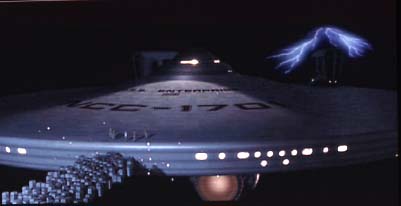
(c) Photofest / Getty Images
The struggles of the special effects staff who created the movie “Star Trek: The Motion Picture” and what they left behind, Part 2
Differences in production style between FGC and Apogee
There was a big problem with the collaboration between FGC and Apogee. FGC was using 65mm 5P (perforation) equipment returned by RA&A, but Apogee was working with VistaVision (35mm 8P) from the old ILM era. So Apogee quickly developed an optical printer that could be used for both 65mm and 35mm.
There are also differences in the way miniatures were shot.(*3) Trumbull was adamant about blue screen compositing, so he combined silhouettes of miniatures shot against a white background with negatives of high-contrast film that had been overexposed against a black background to create a traveling matte effect.
Meanwhile, Apogee was still following the old ILM tradition of using blue screen compositing, and their engineer Jonathan Elland was in the midst of developing new blue screen compositing techniques.

Star Trek: The Motion Picture Copyright (C) 1979 by Paramount Pictures Corporation. All Rights Reserved. (C)2010 Paramount Pictures Corporation. STAR TREK and related marks and logos are trademarks of CBS Studios Inc. All Rights Reserved.
So, by dividing up the work by scene, we tried to reduce the amount of work on the same screen as much as possible. Apogee was responsible for the scenes at the beginning of the film, including the Klingon battleship(*4), the space station Epsilon 9, the photon torpedoes(*5), the transporter, the V'jar probe that infiltrated the bridge of the Enterprise, and all the exterior shots of V'jar.
The rest of the photo was taken by FGC. In particular, the exterior of the Enterprise was painted with a paint that reflected the background color, so there was a risk that the reflection of the blue screen would cause holes in the matte. Therefore, FGC took all the photos using a white/black screen.
He also worked on the blue cloud-like object(*6) that surrounds the V-Gar. The long scene(*7) in which the Enterprise enters the cloud is reminiscent of the slit-scan technique 2001: A Space Odyssey , but was shot using a new method: a monochrome airbrushed painting was repeatedly exposed 20 to 50 times with a motion-controlled Multiplane camera called a Compsie.
*3 In the shots that Trumbull was in charge of, you can see a unique effect of light coming in from outside the frame, which was intentional. The technique was to place a small piece of aluminum foil in front of the lens, shoot only the miniature electric lights, and overlay this with a normally lit image (beauty pass). This off-screen flare effect can also be seen in Close Encounters of the Third Kind of the Third Kind and Blade Runner (1982). When I was in my twenties, I recreated this effect with CG and used it in several commercials.
“Blade Runner” preview
*4 The lightning-like flash that appears when the Klingon battleship is destroyed by V'Ghar was not hand-drawn animation or CG, but a real discharge from a Tesla coil . This discharge is used throughout the film. However, because the Apogee studio was located near Van Nuys Airport, there were complaints about radio interference. This problem was solved by covering the area with wire mesh.
*5 The photon torpedo effect was created using a combination of argon lasers and motion-controlled cameras. Lasers were also used for the light of the transporter and the membrane-like clouds above Vader, among other films such as Space Vampires (1985).
Lasers are also used to represent wormholes. A laser beam is reflected by a mirror that vibrates with a galvanometer scanner, projected onto a rear projection screen, and moved around 6m with a simple motion control camera to create a tunnel-like space. The vibration pattern is generated by connecting the galvanometer scanner to an audio synthesizer and using the principles of an oscilloscope. The original color was blue-green from an argon laser, but was changed to orange through optical processing.
*6 Allison Yerxa, who worked on this scene, was highly praised and was hired as the VFX supervisor for Brainstorm .
*7 The inspiration for this scene came from the educational film Universe (1960), produced by the National Film Board of Canada (NFB). Stanley Kubrick famously watched it repeatedly as reference for 2001: A Space Odyssey.

